Do you want stronger, toned back and shoulder muscles? It’s time to add wings exercises to your back workout routine.
Many fitness enthusiasts focus on building their arms, abs, and chest, but they often forget about the wings (aka the latissimus dorsi muscles).
Having strong wings or an upper back can help improve your posture and prevent back pain.
It’s time to show your wings some love to get a V-shaped body.
In this blog post, we’ll discuss the benefits of wings exercises, different types of wings exercises, and how to use them in your workout routine.
Let’s get started!

- What Are Wings Workout?
- At Home Bodyweight Wings Exercises
- 1. Pull Up
- 2. Inverted Row
- 3. Resistance Bands Lats Pulldown
- Dumbbell Wings Exercises
- 4. One-Arm Dumbbell Row
- 5. Renegade Row
- 6. Dumbbell Deadlift
- Barbell and Gym Machine Wings Exercises
- 7. Bent Over Barbell Rows
- 8. Landmine Row
- 9. Lat Pulldown
- 10. Chest Supported Row
- Wings Workout Plan for Beginners
- At Home Wings Workout Plan
- Anatomy of the Wing Muscles
- Latissimus Dorsi (Lats)
- Rhomboids
- Teres Major
- Teres Minor
- Conclusion
What Are Wings Workout?
Wings workouts refer to training that specifically targets the muscles of the upper back – the lats, rhomboids, and surrounding areas.
These workouts can be done at home or in the gym and can include bodyweight exercises, resistance band exercises, and weightlifting exercises.
Wing workouts have several benefits, including improved posture, increased upper body strength, and a reduced risk of injuries.
Some of the best exercises for the wings are pull-ups, chin-ups, bent rows, dumbbell rows, and deadlifts.
At Home Bodyweight Wings Exercises
You don’t need expensive gym equipment to start making your wings stronger and more defined. There are plenty of bodyweight back exercises you can do at home.
Bodyweight is used as resistance to hit the upper back muscles from all angles.
1. Pull Up
Pull-ups are a compound bodyweight exercise that targets the muscles in the upper body, primarily the latissimus dorsi (lats) of the back, but also the biceps, rhomboids, and deltoids.
The pull-up increases the strength, thickness, and width of your back, specifically your lats. The lats are what influences back width and form the “V” in the upper back.
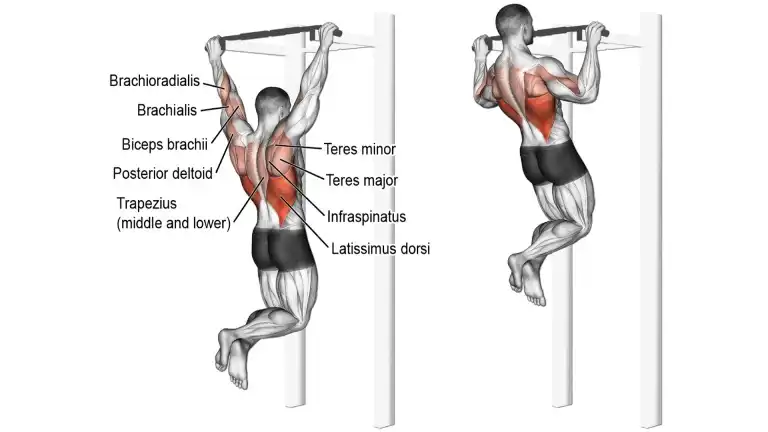
How To Do
- Grab the pull-up bar with your hands shoulder-width apart.
- Palms can face away from you (traditional pull-up) or towards you (chin-up).
- Before you start pulling yourself up, make sure you engage your core and keep your body tightly.
- Use your upper body strength to pull yourself up until your chin is above the bar.
- Slowly lower yourself back to the starting position.
Tips
- Ensure that you’re not using momentum or swinging during the movement.
- Start with assisted pull-ups if you can’t do the full pull-up.
- Exhale as you pull yourself up and inhale as you lower yourself down.
- Go full range of motion and keep form correct.
2. Inverted Row
The inverted row (bodyweight rows) creates a horizontal body position, making it easier to perform. It works the back and shoulder muscles from a different angle and improves upper body strength.
In the gym, most people utilize the Smith machine for this exercise.
You can also do the inverted row at home by lying under a chair and pulling yourself up.

How To Do
- Adjust the height of the chair and bar so that they are a little higher than arm’s length from the floor.
- Lie under the bar with your legs and body straight.
- Grasp the bar with an overhand grip that’s a little wider than shoulder width.
- Keep your legs and body straight and breathe out as you lift your chest up to the bar.
- Hold for a count of two and squeeze your back muscles.
- As you lower your body, breathe in until your arms and shoulders are fully extended. Repeat.
Tips
- Do not allow your butt to sag.
- Keep your elbows tucked in.
- Lower your body until the arms are fully extended, and then raise your body until the chest touches the bar.
3. Resistance Bands Lats Pulldown
The resistance band lats pulldown can be done anywhere, so it’s a good option for home workouts or while travelling.
It is a compound exercise that works multiple muscle groups in the back, especially the latissimus dorsi and teres major.
There are different ways to do the resistance band pull-down exercise for your wings.
- Close-grip pulldown
- Wide-grip lat pulldown
- One-arm pulldown

How To Do
- Attach the resistance band to a sturdy anchor point above your head, such as a door frame.
- Stand facing the anchor point and grab the resistance band with your overhand grip.
- Step back to create tension in the band. Engage your core, slightly lean back.
- Pull the band down towards your chest.
- Slowly release the tension and return to the initial position.
Tips
- Do 3-4 sets of 10-12 repetitions of resistance band lat pulldowns.
- Focus on pulling with your back muscles rather than relying on your arms.
- Make sure you control the movement both on the way down and up.
Dumbbell Wings Exercises
4. One-Arm Dumbbell Row
If you’re looking for straightforward dumbbell wing exercises to add to your routine, the One-arm dumbbell row is a great staple exercise to get you started.
It is an excellent full-range exercise to build the lat muscles. This helps to work on each side independently, thereby providing better muscle isolation and a longer range of motion.
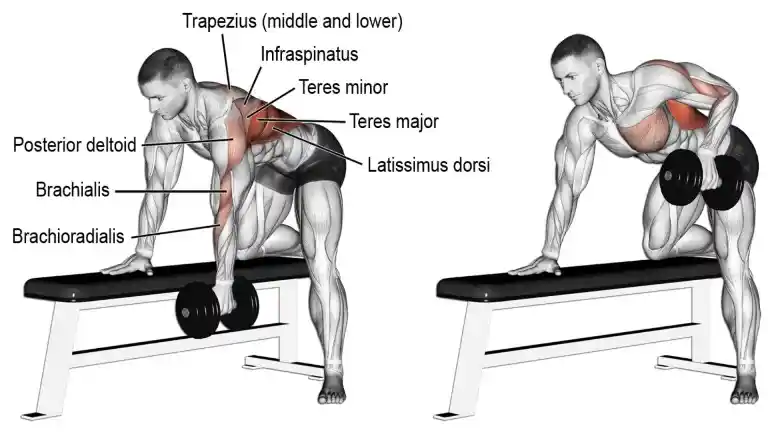
How To Do
- Stand with feet shoulder-width apart.
- Lean forward and place one knee and the same-side hand on the bench.
- Your back should be parallel to the floor, and the other foot should be firmly planted on the ground.
- With the free hand, grab the dumbbell with a neutral grip.
- Engage your lats and pull the dumbbell upward towards your lower ribcage.
- Slowly lower the dumbbell back to the starting position.
- Repeat on the other side.
Tips
- Keep your back straight and head in a neutral position.
- Squeeze your back muscles at the top of each repetition.
5. Renegade Row
The renegade row is also known as a plank row, which is almost a variation of the dumbbell row. It is designed to target the upper back. Like a plank, it is designed to target the core.
The renegade row is a multitasking exercise that tones your back and works your core. This is the best way to build strength and make your wings bigger.

How To Do
- Place two dumbbells on the floor about shoulder-width apart.
- Start in the top position of a push-up position with your hands on the weights.
- Pull your right elbow back and raise the dumbbell toward your chest. Keep your right elbow close to your torso, your abs tight, and your hips in one line.
- Hold the weight for one second at the top and slowly return it to where you started.
- Do the same thing on the other side. Repeat.
Tips
- Keep your body in a straight line from your shoulders to your ankles as you row the weight.
- Move the weight in a smooth, controlled motion.
- You should do the same number of reps for each side.
6. Dumbbell Deadlift
The deadlift is the King of all exercises, and It is a powerful exercise designed to build an overall physique that uses more muscles than any other exercise.
The dumbbell deadlift is the best exercise for posterior chain muscle strengthening, which includes the back, erector spine, glutes, and hamstrings.

How To Do
- Place a dumbbell in front of you. Grab the dumbbells with each of your hands.
- Raise the dumbbell from the ground using your hamstrings and glutes.
- You should keep your legs slightly bent, back straight, and head looking up.
- Raise it to the point where your body is erect.
- Hold the dumbbell for a moment at the top of the lift.
- Now, lower the dumbbell slowly at a steady slow pace by bending at the hips first and then at the knees.
Tips
- If performed incorrectly, the deadlift can cause more harm than good. Keep the back straight at all costs.
- Go full range of motion and maintain the form correct.
Barbell and Gym Machine Wings Exercises
7. Bent Over Barbell Rows
Bent over barbell rows are a compound barbell exercise that targets multiple muscle groups, including the back, shoulders, biceps, forearms, and grip.
It is one of the best exercises for building strength and muscle mass in the wings.
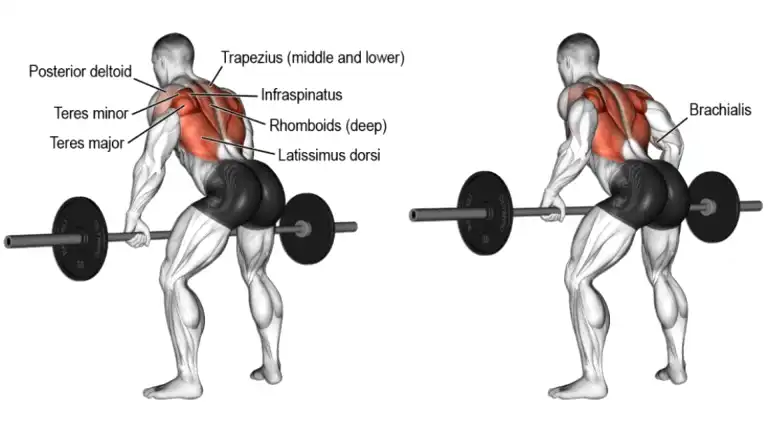
How To Do
- Stand with feet shoulder-width apart. Hold a barbell with an overhand grip, hands just outside of the knees.
- Bend your torso forward at an angle of 45 degrees to the floor and let the bar hang in front of you.
- Pull the barbell towards your lower ribcage.
- Pause at the top of the movement and squeeze your back muscles.
- Slowly lower the barbell back to the starting position.
Tips
- Ensure your back remains straight.
- Keep your head in a neutral position by looking slightly forward.
8. Landmine Row
If you are looking to add freshness and variety to your back workouts and give yourself a new challenge, give this landmine row exercise a try.
Landmine row is empowering and extremely beneficial. It’s an important part of your wings workout.

How To Do
- If you are using a classic bar, you will have to make sure that one of its ends is blocked by placing it in the corner of a wall.
- Get into a bent over position with your spine straight and your chest up.
- Lift the bar up until it almost touches your chest with it.
- Focus on contracting your mid-back muscles by sliding your shoulder blades back.
- Now slowly lower the bar back to the starting position.
Tips
- Make sure your set-up is secure before each exercise.
- To increase range of motion, use small discs, rather than Olympic discs with a large diameter.
9. Lat Pulldown
The Lat Pulldown is one of the most popular and versatile gym machines specifically designed to target the muscles in your back, primarily the latissimus dorsi (or “lats”).
The exercise also engages other muscles including the biceps, trapezius, and shoulders to some extent.
The exercise is easy to learn and very effective at building back strength. The lat pulldown can be performed with different variations.

How To Do
- Make sure you sit down on the lat pulldown machine and the thigh pads.
- Reach up and grasp the bar with an overhand grip, with hands wider than shoulder width apart.
- Keep your back straight while sitting up straight and slightly lean back.
- Pull the bar downwards towards your upper chest. To perform this action, focus on using your lats, not your biceps.
- Slowly return the bar to its starting position.
Tips
- A slight lean is okay, but too much leaning can take the focus away from the lats.
- Hold the contraction for a second to maximize the lats.
- If you have wrist pain, a thumbless grip is a good choice.
10. Chest Supported Row
The chest supported machine row is a special piece of gym equipment that helps you work your wings muscles while also supporting your chest and body.
This machine is an excellent option for those who have lower back issues or simply want to focus exclusively on their upper back muscles, since it minimizes the strain on your lower back.
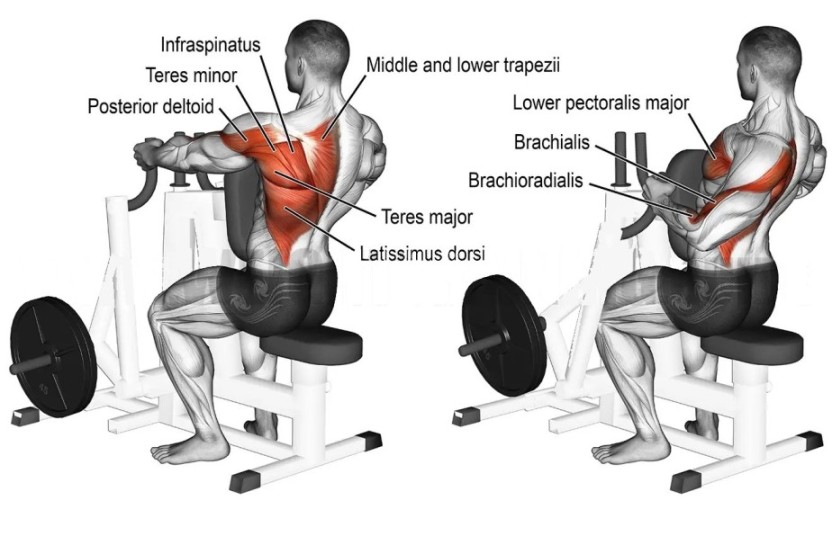
How To Do
- Adjust the seat height so that your feet are comfortable resting on the platform or footrests.
- Sit up straight with a neutral spine. Your chest should be pressing lightly against the chest pad.
- Start by pulling your elbows back towards you.
- As you pull, focus on squeezing your shoulder blades together.
- Slowly release the handles forward in a controlled manner.
- Allow your back muscles to relax as you return to the initial position.
Tips
- Maintain a neutral spine, avoiding excessive arching or rounding.
- Most row machines will offer grip options – wide grip or neutral grip. Please choose based on your preferences.
Wings Workout Plan for Beginners
| Exercise | Sets | Reps |
|---|---|---|
| One-Arm Dumbbell Row | 3 | 8-10 |
| Assisted Pull Up | 3 | 8-10 |
| Lat Pulldown | 4 | 10-20 |
At Home Wings Workout Plan
| Exercise | Sets | Reps |
|---|---|---|
| Pull Ups | 3 | 10-12 |
| Inverted Row | 3 | 8-10 |
| Band Lat pulldown | 4 | 10-12 |
| Dumbbell Pullovers | 4 | 10-12 |
Anatomy of the Wing Muscles
The “wings” primarily refer to the latissimus dorsi muscles, but also encompass several surrounding upper back muscles.
Latissimus Dorsi (Lats)
This broad, flat muscle covers much of the lower back. The lats are responsible for adduction, extension and internal rotation of the shoulder joint. When developed, they create width through the back and that coveted V-taper.
Rhomboids
There are two rhomboid muscles (major and minor) that connect the shoulder blades to the spinal column.
They work to adduct and retract the scapulae (shoulder blades). Strong rhomboids improve posture.
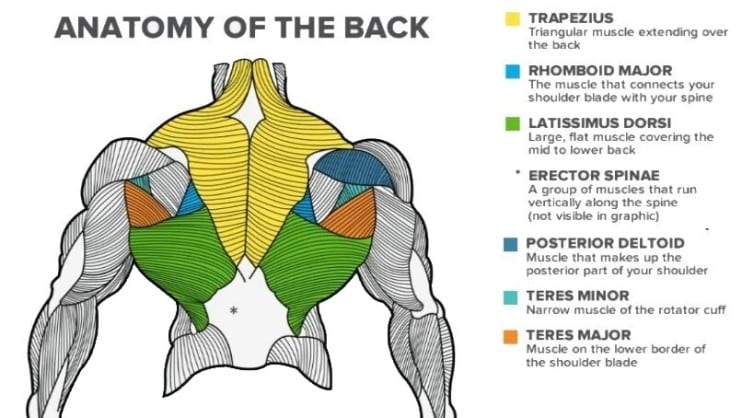
Teres Major
This is a thick, rounded muscle that originates on the outer shoulder blade and inserts on the humerus.
It assists in transverse extension and adduction of the arm.
Teres Minor
Below the teres major, this smaller muscle rotates the arm outward and works with the infraspinatus.
Conclusion
Wings exercises are a great way to strengthen your upper back. These exercises are simple and can be done anywhere.
You can use them to improve your posture, increase your strength, and improve your athletic performance.
References
- Lehman, G. J., Buchan, D. D., Lundy, A., Myers, N., & Nalborczyk, A. (2004). Variations in muscle activation levels during traditional latissimus dorsi weight training exercises: An experimental study.
- Krzysztofik, M.; Wilk, M.; Wojdała, G.; Gołaś, A. Maximizing Muscle Hypertrophy: A Systematic Review of Advanced Resistance Training Techniques and Methods. Int. J. Environ. Res. Public Health 2019, 16, 4897.
- Paton ME, Brown JM. Functional differentiation within latissimus dorsi. Electromyogr Clin Neurophysiol. 1995;35:301–309

Manish brings over 10 years of hands-on experience in weight lifting and fat loss to fitness coaching. He specializes in gym-based training and has a lot of knowledge about exercise, lifting technique, biomechanics, and more.
Through “Fit Life Regime,” he generously shares the insights he’s gained over a decade in the field. His goal is to equip others with the knowledge to start their own fitness journey.
